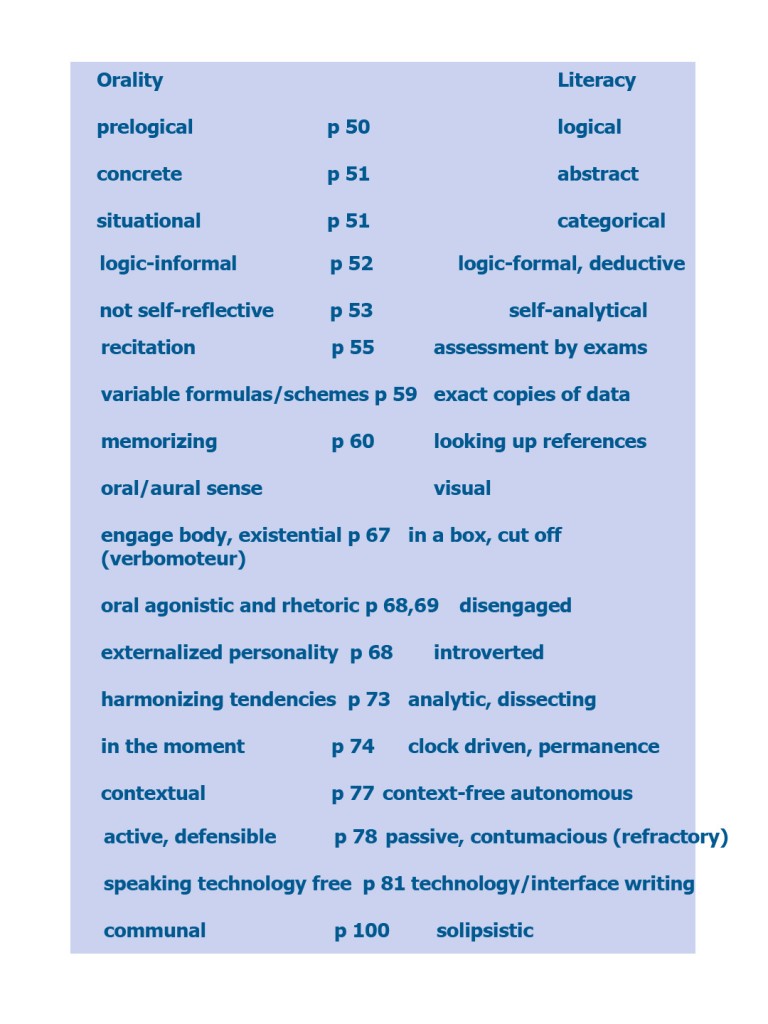From Ong and his critics to O’Donnell, Brand, Kelley and Grafton grappling with some of the more pressing concerns of the digital era (storage, digitization of books and access to same, respectively)—Module 2 covered a lot of ground! I particularly enjoyed Kelley’s discussion of the economic aspects of digitization (shipping books to China for scanning, for example), and contrasting of business models (a much under-rated influence) as the world of copyright and protected copies gives way—not without much wailing and gnashing of teeth—to the age of free (though not worthless—an important distinction) digital copies. Kelley is correct: “The reign of the copy is no match for the bias of technology” (2006, p. 13).
The question of how this progression of technologies has and will continue to modify reading and writing and thus education is not just at the centre of this module, but of the course. I couldn’t help, however, relating this discussion to one in which I have been engaged for some time now concerning the role of information and communication technologies (computers, cell phones, smart phones, social networking applications, etc.) in the lives and learning of our students. As a secondary teacher, I tend to think of that age group first in this regard, particularly since I believe it’s still the age (13-18) of most rapid adoption and most intense use. Having said that, I am regularly told of middle schoolers developing cell phone and Facebook habits to rival those of their older contemporaries, and undergrads still inhabiting the high school world of more than a thousand text messages a day and religious, narcissistic Facebook updating.
This particular facet of technology in schools: the uses it is put to by teens and the effect it has on their learning, was the focus of our school pro-d Sept. 25—which I inadvertently became involved in organizing. I’m not on the pro-d committee, but as the teacher-librarian responsible for purchasing, I was asked to order 80 copies of the book The Dumbest Generation: How the Digital Age Stupefies Young Americans and Jeopardizes Our Future —one for each member of the teaching staff. They arrived on the last day of school in June and were distributed for summer reading. Then last month I was again recruited to set up a Skype discussion with the author, Mark Bauerlein, an Emory University professor. Bauerlein acknowledges that the title is a provocation and adds that he is not a technophobe. One of his main arguments is that while there is clearly tremendous power in the current technologies of reading and writing that we employ (email, databases, online access to thousands of books and newspapers, blogs, wikis, etc.), and we would certainly not want to give them up, the uses to which teens put them as a result of their developmental stage locks them into a kind of adolescent feedback loop. This narrow preoccupation unnaturally extends adolescence (mentally, at least) to the detriment of acquiring knowledge and maturity—which are, after all, also important functions of secondary and post-secondary education. Bauerlein opened our 67-minute pro-d Skype session with a 15-minute summary of his thesis, and then fielded questions from teachers. He was challenged as often as he was lauded, but I must admit, I find his argument persuasive an in accordance with my observations and those of many of my colleagues. I have been teaching secondary full-time for a decade now, so I experienced roughly five years of little to no cell phone and Facebook penetration before the explosion in their use of the last five years. Again, I think Bauerlein is correct to worry about the quality of communication texting and the Facebook Bathroom Wall promote as well as the 24/7 intrusion of adolescent concerns (What are my friends doing? Where are we meeting tomorrow? Who said what about whom?) that these technologies permit. The mental space and even quiescence that used to exist when teens were alone at home in their rooms reading or doing homework no longer exists thanks to texting and Facebook. Bauerlein suggests that the current technologies allow teens to become far too self-referential and this crowds out the (previously) natural expansion of interests to less egocentric concerns. Of course, there is still the top 10 percent who will use ICTs to organize peace rallies and email pictures of a toxic spill to the traditional media (after starting a Facebook and Twitter group on the topic). It’s the other 90 percent he worries about—and I agree. In any case, coming out of this pro-d dialogue, I may have come off a little more curmudgeonly than usual over in the Orality and Literacy discussion where I chimed in with some of these musings in a thread started by Drew. I’ll see if I can attach an excerpt of the Skype discussion with Bauerlein. (He gave me permission to record the exchange.)
Note: Bauerlein does allow that most of the studies in his book are American and his observations are about U.S. teens. I would submit, however, that based on similar Canadian studies I have seen, the behaviour of Canadian teens is not significantly different where ICT use is concerned.
References
Bauerlein, M. (2008). The Dumbest Generation: How the Digital Age Stupefies Young Americans and Jeopardizes Our Future. New York: Jeremy P. Tarcher.
Kelley, K. (16 May 2006). Scan This Book! New York Times.

